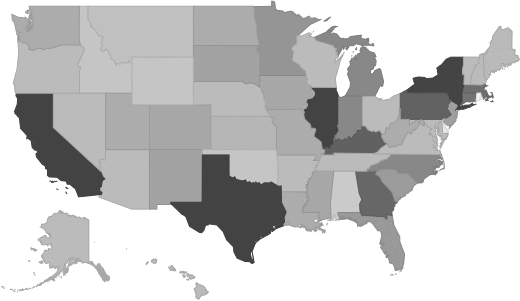Community Food & Housing & Emergency Relief Services Industry - Market Research Report
Industry Overview
This industry group comprises establishments primarily engaged in one of the following: (1) collecting, preparing, and delivering food for the needy; (2) providing short-term emergency shelter, temporary residential shelter, transitional housing, volunteer construction or repair of low-cost housing, and/or repair of homes for individuals or families in need; or (3) providing food, shelter, clothing, medical relief, resettlement, and counseling to victims of domestic or international disasters or conflicts (e.g., wars).
Source: U.S. Census BureauMarket Size and Industry Forecast
This research report analyzes the market size and trends in the Community Food and Housing and Emergency Relief Services industry. It shows overall market size from 2020 to the present, and predicts industry growth through 2030. Revenues data include both public and private companies.
| Historical | Forecasted |
|---|
| 2020 | 2021 | 2022 | 2023 | 2024 | 2025 | 2026 | 2027 | 2028 | 2029 | 2030 |
|---|
| Market Size (Total Revenue) | Included in Report |
| % Growth Rate |
| Number of Companies |
| Total Employees |
| Average Revenue per Company |
| Average Employees per Company |
Source: U.S. government financial dataIndustry Revenue ($ Billions)

Industry Forecast ($ Billions)

Advanced econometric models forecast five years of industry growth based on short- and long-term trend analysis. Market size includes revenue generated from all products and services sold within the industry.
Geographic Breakdown by U.S. State
Market size by state reveals local opportunity through the number of companies located in the region. Each state's growth rate is affected by regional economic conditions. Data by state can be used to pinpoint profitable and nonprofitable locations for Community Food & Housing & Emergency Relief Services companies in the United States.
Community Food & Housing & Emergency Relief Services Revenue by State

Distribution by Company Size
| Company Size | All Industries | Community Food & Housing & Emergency Relief Services |
|---|
| Small Business (< 5 Employees) | Included |
| Small Business (5 - 20) |
| Midsized Business (20 - 100) |
| Large Business (100 - 500) |
| Enterprise (> 500) |
Community Food & Housing & Emergency Relief Services Industry Income Statement (Average Financial Metrics)
Financial statement analysis determines averages for the following industry forces:
- Cost of goods sold
- Compensation of officers
- Salaries and wages
- Employee benefit programs
- Rent paid
- Advertising and marketing budgets
The report includes a traditional income statement from an "average" company (both public and private companies are included).
| Industry Average | Percent of Sales |
|---|
| Total Revenue | Included |
| Operating Revenue |
| Cost of Goods Sold (COGS) |
| Gross Profit |
| Operating Expenses |
| Operating Income |
| Non-Operating Income |
| Earnings Before Interest and Taxes (EBIT) |
| Interest Expense |
| Earnings Before Taxes |
| Income Tax |
| Net Profit |
Average Income Statement

Cost of Goods Sold
Salaries, Wages, and Benefits
Rent
Advertising
Depreciation and Amortization
Officer Compensation
Net Income
Financial Ratio Analysis
Financial ratios allow a company's performance to be compared against that of its peers.
| Financial Ratio | Industry Average |
|---|
| Profitability Ratios | Included |
| Profit Margin |
| ROE |
| ROA |
| Liquidity Ratios |
| Current Ratio |
| Quick Ratio |
| Activity Ratios |
| Average Collection Period |
| Asset Turnover Ratio |
| Receivables Turnover Ratio |
| Inventory Conversion Ratio |
Products and Services Mix
Product lines and services in the Community Food & Housing & Emergency Relief Services industry accounting for the largest revenue sources.
| Product Description | Description | Revenue
($ Millions) |
|---|
| Industry total | Included |
| Contributions, gifts, & grants - private |
| Contributions, gifts, & grants - government |
| Social assistance related to shelter for the general population |
| Food services for the general population |
| Food services - general pop - collection/distrib of donated food |
| All other revenue |
| Social assistance services for immigrants & refugees |
| Social assistance for immigrants - emergency relief services |
| Transitional housing services |
Salary information for employees working in the Community Food & Housing & Emergency Relief Services industry.
| Title | Percent of Workforce | Bottom Quartile | Average (Median) Salary | Upper Quartile |
|---|
| Management Occupations | 12% | Included |
| Chief Executives | 1% |
| General and Operations Managers | 3% |
| Other Management Occupations | 6% |
| Business and Financial Operations Occupations | 8% |
| Business Operations Specialists | 6% |
| Community and Social Service Occupations | 30% |
| Counselors, Social Workers, and Other Community and Social Service Specialists | 30% |
| Social Workers | 8% |
| Child, Family, and School Social Workers | 5% |
| Miscellaneous Community and Social Service Specialists | 17% |
| Social and Human Service Assistants | 13% |
| Personal Care and Service Occupations | 10% |
| Other Personal Care and Service Workers | 9% |
| Residential Advisors | 5% |
| Residential Advisors | 5% |
| Office and Administrative Support Occupations | 14% |
| Transportation and Material Moving Occupations | 6% |
Government Contracts
The federal government spent an annual total of
$344,295,168 on the community food & housing & emergency relief services industry. It has awarded 1,107 contracts to 308 companies, with an average value of $1,117,841 per company.
Top Companies in Community Food & Housing & Emergency Relief Services and Adjacent Industries
| Company | Address | Revenue
($ Millions) |
|---|
Included |



